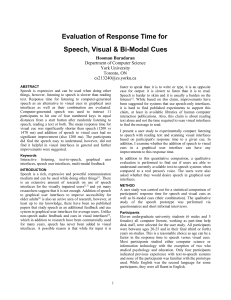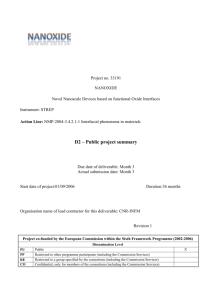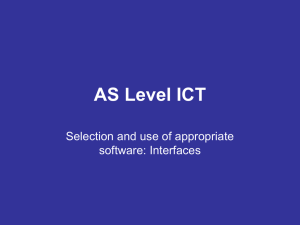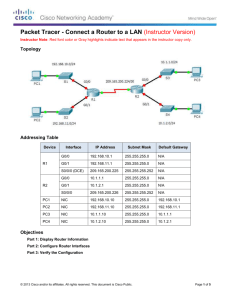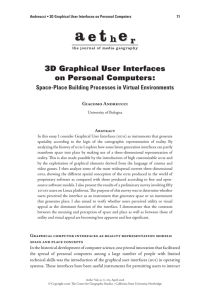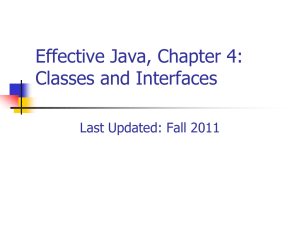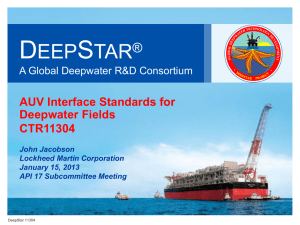Interfaces and Interactions: 1990`s
advertisement
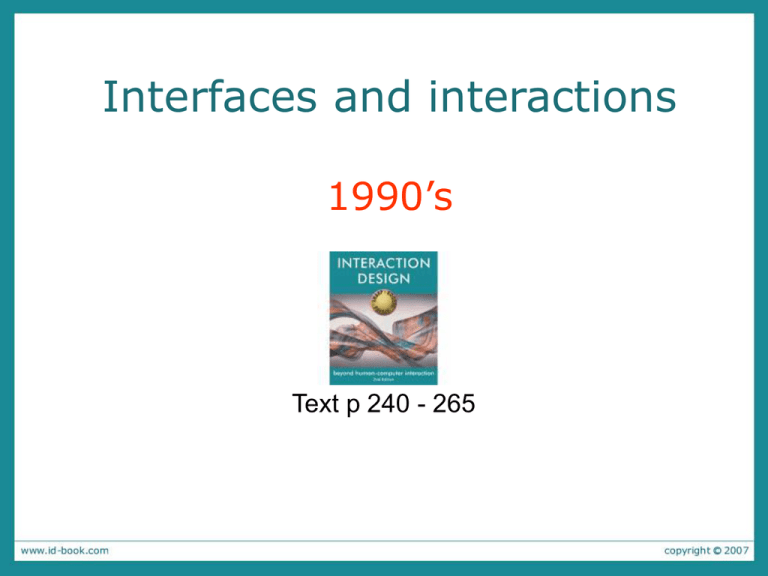
Interfaces and interactions 1990’s Text p 240 - 265 Interface types 1980s interfaces Command WIMP/GUI 1990s interfaces Advanced graphical (multimedia, virtual reality, information visualization) Web Speech (voice) Pen, gesture, and touch Appliance 2000s interfaces Mobile Multimodal Shareable Tangible Augmented & mixed reality Wearable Robotic Advanced graphical interfaces • Advanced graphical interfaces exist now that extend how users can access, explore, and visualize information – e.g. interactive animations, multimedia, virtual environments, and visualizations • Some designed to be viewed and used by individuals • Others by users who are collocated or at a distance Multimedia • Combines different media within a single interface with various forms of interactivity – graphics, text, video, sound, and animations • Users click on links in an image or text -> another part of the program -> an animation or a video clip is played -> can return to where they were or move on to another place BioBlast BioBlast is a multimedia learning environment for secondary biology classes that incorporates simulation models based on NASA’s research to enable students to develop and test their own designs for a life support system for use on the Moon. Multimedia pros and cons • Facilitates rapid access to multiple representations of information • Can provide better ways of presenting information than can either one alone • Can enable easier learning, better understanding, more engagement, and more pleasure • Can encourage users to explore different parts of a game or story • Tendency to play video clips and animations, while skimming through accompanying text or diagrams Research and design issues • How to design multimedia to help users explore, keep track of, and integrate the multiple representations – provide hands-on interactivities and simulations that the user has to complete to solve a task – Use ‘dynalinking,’ where information depicted in one window explicitly changes in relation to what happens in another (Scaife and Rogers, 1996) • Several guidelines around that recommend how to combine multiple media for different kinds of task Virtual reality and virtual environments • Computer-generated graphical simulations providing: – “the illusion of participation in a synthetic environment rather than external observation of such an environment” (Gigante, 1993) • provide new kinds of experience, enabling users to interact with objects and navigate in 3D space • Create highly engaging user experiences Pros and cons • Can have a higher level of fidelity with the objects they represent, c.f. multimedia • Induces a sense of presence where someone is totally engrossed by the experience – “a state of consciousness, the (psychological) sense of being in the virtual environment” (Slater and Wilbur, 1999) • Provides different viewpoints: 1st and 3rd person • Head-mounted displays are uncomfortable to wear, & can cause motion sickness and disorientation Research and design issues • Much research on how to design safe and realistic VRs to facilitate training – e.g., flying simulators – help people overcome phobias (e.g., spiders, talking in public) • Design issues – how best to navigate through them (e.g., first versus third person) – how to control interactions and movements (e.g., use of head and body movements) – how best to interact with information (e.g., use of keypads, pointing, joystick buttons); – level of realism to aim for to engender a sense of presence Which is the most engaging game of Snake? Information Visualisation • Concerned with the design of computer generated visualisations of complex data that are interactive & dynamic • Goal is to amplify human cognition enabling users to see patterns, trends and anomalies in the visualisation and from this gain insight • Developed by experts to enable them to understand & make sense of vast amounts of dynamically changing domain data or information eg satellite images MarketMap Marketmap represents changes in stocks and shares over time using rollovers to show additional informatio n Research and Design issues • Research has focused on developing algorithms and interactive techniques to enable viewers to explore and visualise data in nov3el ways • Less research on how visualisations are used in practice and whether they can amplify cognition • Design issues include – – – – – – choices between animation and/or interactivity What form of coding ( colour or text) 2D or 3D representational navigation (zooming, panning) Additional information – what kind, how much Type of metaphor to be used • Currently no clear cut guidelines – an evolving research area Web based interfaces • Early websites were largely text-based, providing hyperlinks • Concern was with how best to structure information at the interface to enable users to navigate and access it easily and quickly • Nowadays, more emphasis on making pages distinctive, striking, and pleasurable ‘vanilla’ or ‘multiflavour’ What do you think? Swim Useit.com Jacob Nielsen argues website homepages should use little images for usability reason Usability versus attractiveness debate • Vanilla or multi-flavor design? – Ease of finding something versus aesthetic and enjoyable experience • Web designers are: – “thinking great literature” • Users read the web like a: – “billboard going by at 60 miles an hour” (Krug, 2000) • Need to determine how to brand a web page to catch and keep ‘eyeballs’ Research and design issues • Web interfaces are getting more like GUIs • Need to consider how best to design, present, and structure information and system behaviour • But also content and navigation are central • Veen’s design principles (1)Where am I? (2)Where can I go? (3) What’s here? What kind of site? Look at the Nike.com website • What kind of website is it? • How does it contravene the design principles outlined by Veen? • Does it matter? • What kind of user experience is it providing for? View notes for a comment • What was your experience of engaging with it? Speech interfaces • Where a person talks with a system that has a spoken language application, e.g., timetable, travel planner • Used most for inquiring about very specific information, e.g., flight times or to perform a transaction, e.g., buy a ticket • Also used by people with disabilities – e.g., speech recognition word processors, page scanners, web readers, home control systems Have speech interfaces come of age? Get me a human operator! • Most popular use of speech interfaces currently is for call routing • Caller-led speech where users state their needs in their own words – e.g., “I’m having problems with my voice mail” • Idea is they are automatically forwarded to the appropriate service • What is your experience of such systems? Format • Directed dialogs are where the system is in control of the conversation • Ask specific questions and require specific responses • More flexible systems allow the user to take the initiative: – e.g., “I’d like to go to Paris next Monday for two weeks.” • More chance of error, since caller might assume that the system is like a human • Guided prompts can help callers back on track – e.g., “Sorry I did not get all that. Did you say you wanted to fly next Monday?” Research and design issues • How to design systems that can keep conversation on track – help people navigate efficiently through a menu system – enable them to easily recover from errors – guide those who are vague or ambiguous in their requests for information or services • Type of voice actor (e.g., male, female, neutral, or dialect) – Do people prefer to listen to and are more patient with a female or male voice? What type of accent? Pen, gesture and touchscreen interfaces • A number of input devices have been developed to investigate whether more fluid and natural physical actions that humans use are was of interacting with information at the interface • Touchscreens have been designed to enable users to use their finger tips to select options at an interface and move objects around interactive table surfaces • Sony’s EyeToy is a digital camera device connected to a play station that enables users to play various video games. The camera films the player standing in front of the TV projecting their image onto the screen, making them the central character of the game. Pen, gesture and touchscreen interfaces • Pen based input is commonly used with PDA’s and large displays instead of mouse or keyboard input. • Flow of interaction can be easily interrupted with pens • More difficult to select menu options – • Tablet PC’s have significantly advanced handwriting recognition and conversion techniques Research and design issues Gesture research concerned with different roles they play in communication Key design concern with all these forms of input is to consider how a computer system recognises and delineates the users gestures- especially how to determine the start and end point in a hand movement etc Summary • Web interfaces are becoming more like multimedia-based interfaces • An important concern that underlies the design of any kind of interface is how information is represented to the user so they can carry out ongoing activity or task


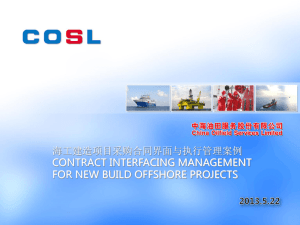


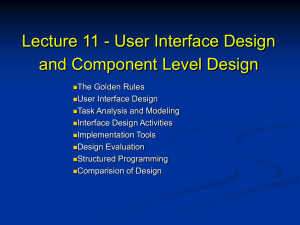
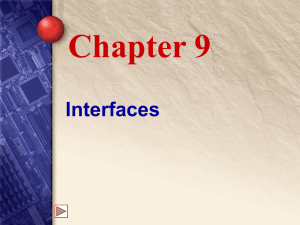
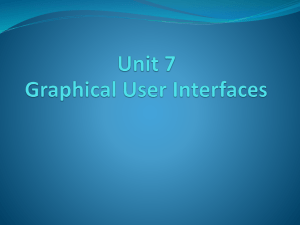
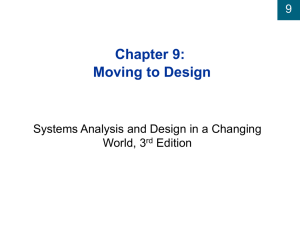
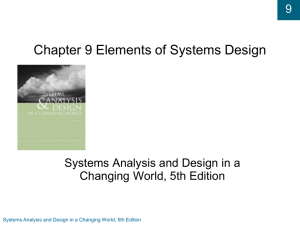
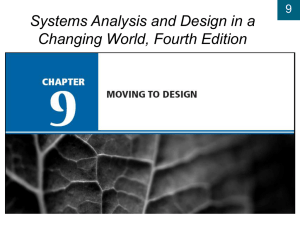
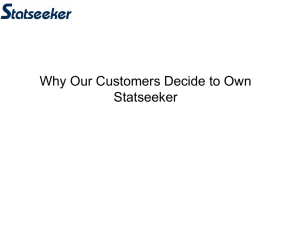
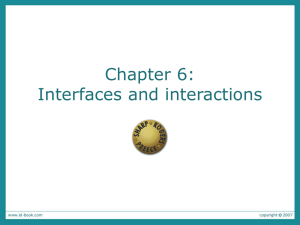
![[#FACT-601] Facter produces mangled output with plaintext output](http://s3.studylib.net/store/data/007721136_2-fbd2ae06b72fa532ebaf093d50077b65-300x300.png)
